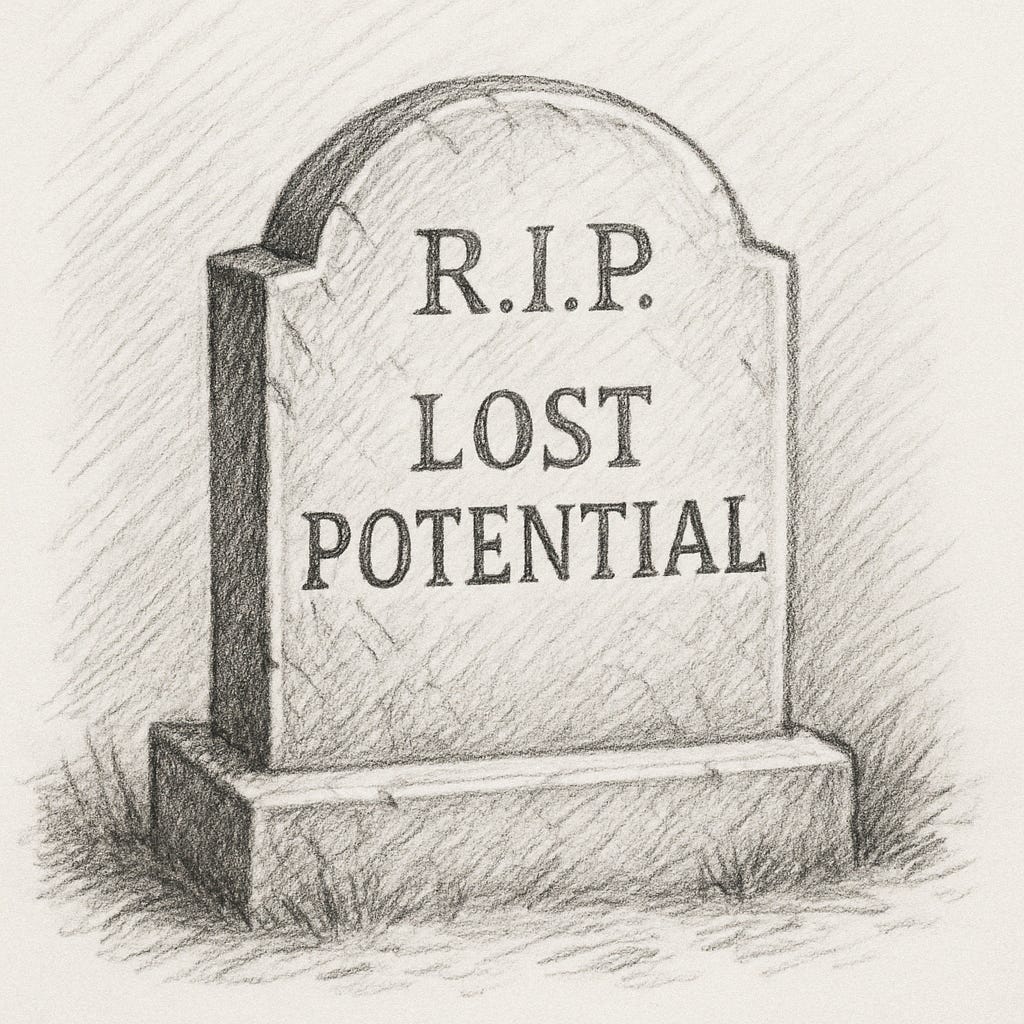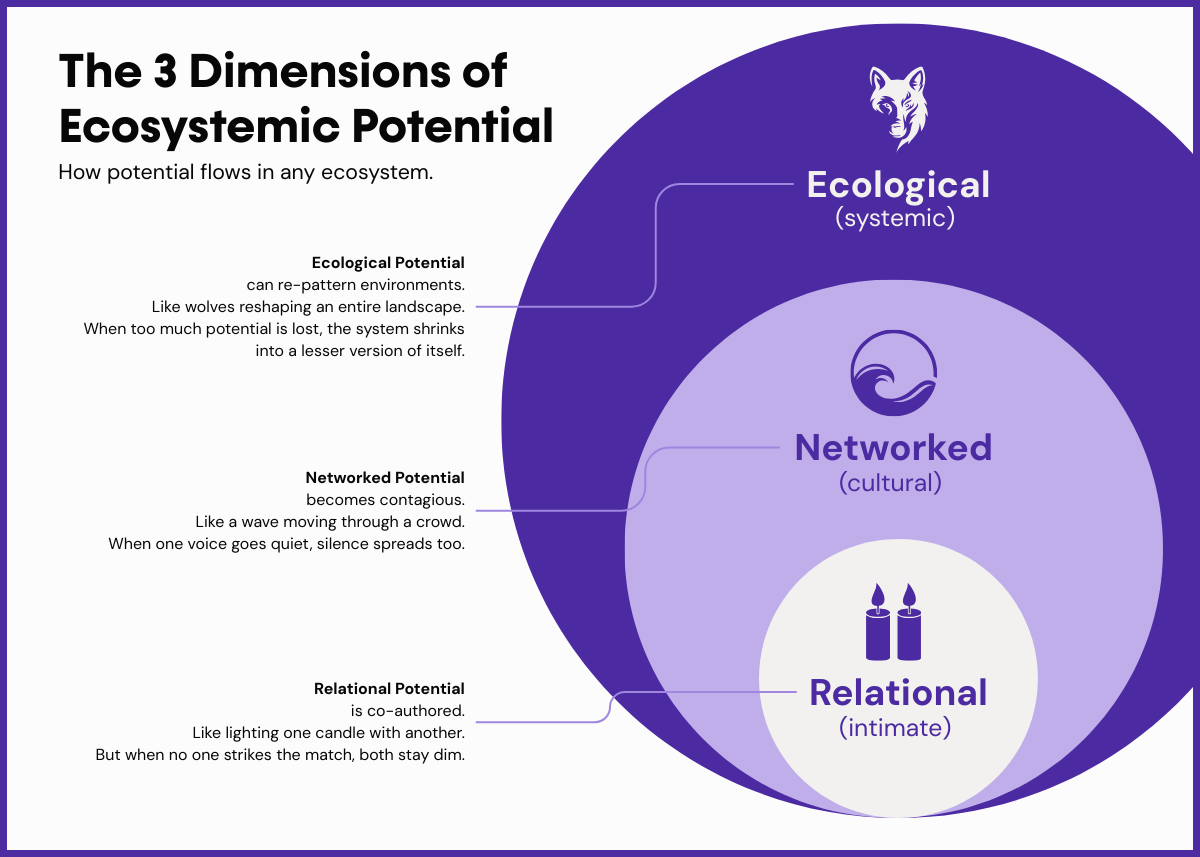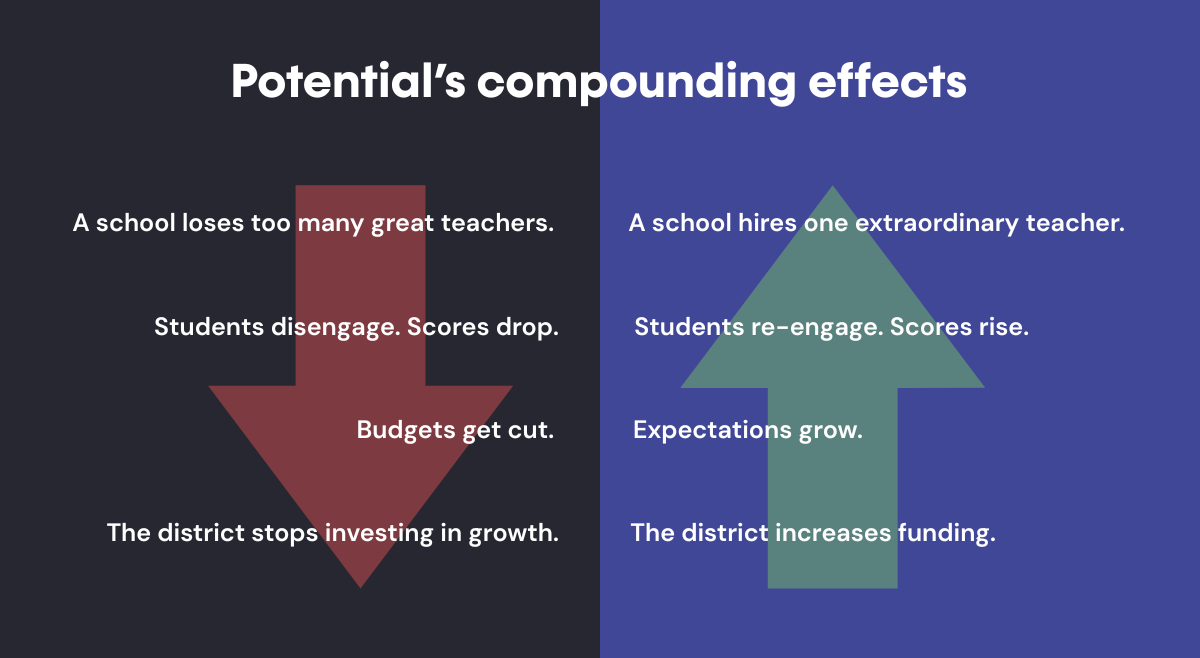1-2: The Cost Of What Never Happened
The network theory of human potential—and the silent tax we all pay when it goes unrealized.
In the last post (1-1), I asked:
“What do we lose when someone else doesn’t realize their potential?”
Your reaction might be, "Well, isn’t that their loss? How am I affected?"
But the more I sat with this, the more that narrative falls apart. Because what if the cost of unrealized potential isn't just individual?
What if it's actually relational? Ecological?
What if potential—especially the unrealized variety—doesn't stay contained to the individual but ripples outward?
That's the idea I want to explore with you today.
Is wasted potential just a personal tragedy—
Or a quiet tax on everyone?
Put another way, how does one person’s unrealized, untapped potential cost all of us?
The cost of what didn’t happen
How do you point to what never happened?
How do you measure the child who was never guided?
The idea that never took root?
You can’t, can you?
There are no metrics for unrealized potential.
No spreadsheets tracking what didn’t get built.
No headlines mourning what never had the chance to begin.
And yet—you feel it, don’t you?
Maybe it’s the silence of classrooms where curiosity should live.
Or in the meetings where initiative dies quietly in cubicles.
And in neighborhoods where the hum of possibility has been replaced by sirens.
You feel it in families trying to survive systems that were never designed for their healing.
Or maybe, it looks like regret…
My father did his best. My mother did too, in her own way.
But mental illness, trauma, and poverty leave their fingerprints on everything.
They shape your starting line and limit your margin for error.
What did I know? I was just another knucklehead kid.
Still, I was into computers in the early ’80s, programming in BASIC and machine language while most people were still figuring out what a mouse was. I knew more than my computer teacher.
And then… I drifted, then left it altogether.
I didn’t graduate high school on time. Tried college three times—dropped out three times.
Guess what happened next? I completely missed that tech tidal wave.
You know the one that launched careers, startups, and billion-dollar companies. The one that created generational wealth.
I became just a guy with ideas, watching from the edges, wondering what might’ve been different if I’d had a little more guidance… or maybe just a quieter home.
So much of what I lost wasn’t visible from the outside.
But I still carry it.
Not as shame—but as clarity.
Because I’ve seen the cost of what didn't happen up close.
The costs snowball over time
Working in youth counseling, I met some of the brightest, most impressionable kids you could imagine. And I watched the system fail them, over and over and over again.
I watched them slip away after I clocked out.
I watched them turn to others who had more to offer in their moment of need.
I watched the light fade from their eyes… replaced by a hardened, more cynical look.
Some left this world within a few years.
Some by gunfire.
Some by their own hand.
And the ones who stayed burdened others.
You see, it wasn’t just what they didn’t become—it was everything lost.
What their lives might have set in motion.
That’s the cost of what didn’t happen. And that cost doesn’t live in a single moment—it snowballs over time.
Put another way, lost potential doesn’t just disappear.
It compounds in the other direction.
Because what one person doesn’t build, others can’t build upon.
And when it happens enough times, it leaves holes—
In lives, in communities, in what the future could have been.
These are the losses we never name.
They don't appear in data sets or spreadsheets.
They don't get written into quarterly reports.
They’ll never make it into the narrative we call progress or history.
But they’re there.
They’re in our regrets.
In our post-mortems.
They’re in our “shoulda, coulda, woulda” talk.
And here’s a hard truth to swallow: The system isn’t broken. It works exactly as designed.
We simply don’t know how to tap into each other’s vast potential. We just don’t.
And that includes our children.
Our colleagues.
Our communities and societies.
Not systematically or consistently, anyway.
And that’s more urgent than every before—
Because potential is really ecosystemic.
When one person ‘fails’ it affects all of us.
The ecosystemic-ness of potential
What one person doesn’t realize doesn’t just stay with them.
It reshapes our collective future.
We talk about success like it’s a solo mission. But that’s never been true.
Senator Elizabeth Warren once said:
“You built a factory? Good for you.
But you moved your goods on roads the rest of us paid for.
You hired workers the rest of us educated.
You were safe because of police and firefighters the rest of us funded.”
Her point wasn’t to diminish individual achievement.
It was to remind us: nobody builds anything alone.
Not a factory.
Not a company.
Not even a life.
We are entangled in the systems that made us.
The roads. The books. The care. The belief.
And the quiet scaffolding of unnamed people who invested in us—whether we noticed them or not.
Potential isn’t just personal—it never was
When someone realizes their potential, we celebrate it as individual greatness.
But when you zoom out, the story changes:
One teacher took a risk on a student.
That student starts a nonprofit.
The nonprofit inspires others to launch their own.
And 15 years later, a generation has changed—because someone cared.
Now flip it.
What happens when someone doesn’t get the help?
Doesn’t get the spark?
Doesn’t get the opportunity?
And what we lose isn’t just their life’s work.
We lose everything it might’ve set in motion.
That’s the part we miss.
Because potential doesn’t sit still.
It either expands outward—or leaves a vacuum in its place.
And that vacuum? It doesn’t stay empty.
It reshapes the ecosystem around it.
What happens in a shrinking ecosystem
I’ve seen it up close.
A personal tragedy starts with a gun-related death.
A suicide follows.
Then the ripple:
A sibling gives up.
A cousin drops out.
A mother’s heart hardens.
A community grows quiet.
We call it “a bad situation.”
But often, those “bad situations” wait downstream from unrealized potential.
Over time, the system doesn’t get stronger.
It adapts—by expecting less.
That’s the ecological nature of potential.
It rewires the entire system around it, whether it grows or dies.
What happens when potential goes unrealized?
Most people think: nothing happens. No action, no output, no consequence.
But ecosystems don’t work that way.
Because even when potential lies dormant, it’s still present with us.
Still part of the system. Still shaping the environment it sits in.
More than that, unrealized potential doesn’t just vanish; it creates a vacuum.
It redirects energy. It lowers the ceiling for everyone around it.
Like a missing instrument in an orchestra.
Like a keystone species removed from an ecosystem (more on this later).
This is the part we miss.
Potential never had to be expressed to make its impact.
Even when it’s suppressed, avoided, or ignored—it still alters everything around it.
And that’s why we need a new map. A new way to look at the world.
Not of what potential could become someday,
but of what it already does—whether it’s activated or not.
That’s where this concept of ecosystemic potential comes in.
It’s not just an idea. It’s a structure. A pattern. A physics of possibility.
Because all potential—activated or not—moves through three distinct channels:
Relational: How it flows between people
Networked: How it amplifies or degrades across systems
Ecological: How it reshapes the conditions it lives in
And if we can start to see potential this way—
Not as a personal or individual trait, but as a networked force—
Then maybe we can address it properly and build a more effective system.
Three ways potential shapes ecosystems
Potential doesn’t live in isolation.
It moves between people.
It travels through systems.
It compounds across generations.
But here’s the key:
It doesn’t move randomly.
It moves through relationship, infrastructure, and environment.
These aren’t metaphors. They’re mechanisms.
If we want to understand how potential activates—or gets lost—we need to understand how it flows.
Let’s break it down.
1. Relational Potential
Relational Potential shows up as person-to-person influence.
This is the most intimate layer of potential.
It’s what you feel when someone sees something in you—and suddenly, you do too.
It’s belief, passed hand-to-hand.
The teacher who guides you.
The coach who pushes you.
The friend who says, “You’ve got something.”
In this way, potential travels through people.
It’s contagious.
One person lights up, others follow.
One voice goes quiet, others hesitate.
That’s why potential is never fully personal. It’s always co-authored.
And it rarely thrives in isolation.
“Even the most successful people didn’t build alone.”
You moved your goods to market on roads the rest of us paid for.
2. Networked Potential
This is how patterns of potential ripple across a larger system.
It’s the difference between one act of courage—and a culture of courage.
One voice speaking up—and a team that starts listening.
One neighborhood reinvesting—and a city remembering what’s possible.
Networked potential lives in the social field.
It’s not just what one person does—
It’s what the people around them start to believe they can do, too.
This is potential moving like current—replicated, reinforced, amplified.
When these signals stack up, they don’t just shift behavior.
They shift every norm.
Relational potential is personal.
Networked potential is viral.
It’s how change catches.
The Forest Beneath the Forest
When you walk through a forest, you’re not just walking over dirt.
You’re walking over an invisible network—miles of mycelium stretching under the soil. A fungal web that connects every tree, every plant, every root system.
Scientists call it the “Wood Wide Web.”
Through this network, trees share nutrients. They warn each other about disease. Dying trees release their remaining energy into the system—feeding the next generation.
The strongest trees don’t just thrive alone.
They thrive because they’re connected.
And when that network is disrupted—by logging, pollution, or isolation—growth slows. The system weakens.
It’s not that the potential disappears.
It just can’t flow anymore.
And when potential can’t move, nothing else can either.3. Ecological Potential
This is the deepest layer.
This is where potential—expressed or suppressed—can re-pattern entire ecosystems.
It’s not about a person or a team.
It’s about what the system learns to expect.
A workplace burns out its most creative minds.
The rest go quiet.
Ambition is replaced by caution.
And culture settles into safety.
A neighborhood loses a generation to disinvestment.
The next stops dreaming entirely.
This is the layer most people never notice—until it’s too late.
Because the system doesn’t break.
It simply adjusts downward.
But it works the other way too.
Reintroduce the right catalyst—like wolves in Yellowstone—and
systems don’t just repair. They regenerate.
That’s ecological potential.
The Wolves That Changed Rivers
In 1995, Yellowstone National Park reintroduced gray wolves after a 70-year absence.
At first glance, it was a predator problem. The elk population had exploded without wolves around, overgrazing the landscape and stripping riverbanks bare.
What followed surprised even the ecologists.
When wolves returned, they didn’t just control the elk. They changed the behavior of the elk. Grazing herds avoided open valleys and river edges—places where they were more vulnerable. That gave overgrazed willows, aspens, and cottonwoods a chance to regrow.
Then trees came back. So did birds.
Beavers returned too, building dams that created new aquatic habitats. Otters, fish, ducks, and reptiles followed.
And with stronger vegetation along the riverbanks, erosion slowed.
The rivers literally began to flow differently—because of wolves.
An entire valley regenerated.
Not because wolves fixed the ecosystem.
But because they unlocked it.Keep this in mind:
Ecosystems don’t just suffer from what's present.
They also suffer from what’s absent.
And so do we.
Ecosystems don’t lie.
You can fake performance.
You can hit metrics and still miss meaning.
But you can’t fake a thriving ecosystem.
It either is—or it isn’t.
You either feel it—or you don’t.
Ecosystemic potential is how we move from a world of quiet resignation
to one of silent regeneration.
But if that shift is going to happen,
we have to stop treating potential like a private good, or a personal trait.
Because what we do with it—or don’t—changes everything.
So what’s the cost of what never happened?
It’s not just the invention we lost.
Or the student who slipped away.
Or the team that went quiet.
It’s the chain reaction they never got to start.
The room that never lit up.
The signal that never spread.
The culture that learned to expect less.
That’s what ecosystemic loss looks like.
And if we don’t interrupt the pattern, the losses don’t stay isolated.
They become our expectations.
They become our culture.
And slowly, we become lesser versions of ourselves—
as do the systems we live in.
Next, we’ll dive into how reality becomes real, and how that affects potential.
Coming up: Reality Architecture, Part I: Beliefs







